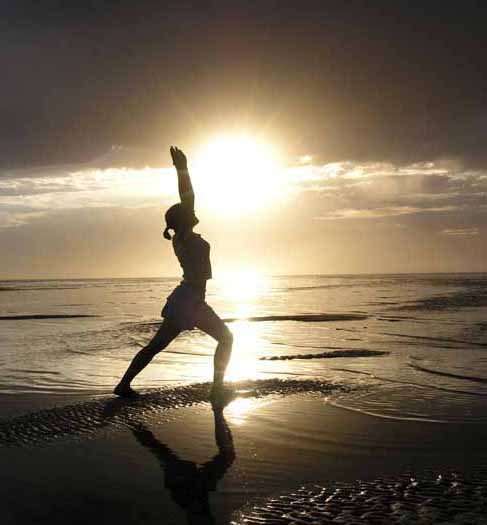

Qi Gong (pronounced Chi Kung) is an ancient Chinese energy (Chi) practice. Qi means energy. It is part of the healing and energy work people do today to create balance within and hopefully carry it into their lives. All one is really doing is shifting energy to balance unstable brain chemistry.
The Chinese character "Gong" represents the effort placed into Qi practice as well as the power gained through such practice. Qigong literally means the meditation practice of Qi energy.
Qigong is based on the concept of Chi, energy which flows through the body. There are 460 movements to learn in the Qigong and related Tai Chi programs. Breathing techniques help the chi flow. It is a self healing practice that can lead to the connection of mind, body and spirit. Images and symbols may be mentally used to assist with the healing.
Qigong is considered part of alternative medicine, with positive effects on various ailments. Some researchers are skeptical of some of the claims for qigong and label the subject matter a pseudoscience. In addition, the origin and nature of qigong practice has led to misconceptions and misuses. The abuse of qigong practice had led to the formation of cults and potential psychiatric problems.
The ancient history of qigong are identified with the segment within Chinese society where the training is cultivated. Over time, the concept and practice of different types of qigong acquired similar philosophical bases. Within the last three decades, those exercises were explained from a scientific basis. The common thread throughout history is the increasing popularity of this system of mindful practice, which has spread throughout China and now across the world.
The history of Chinese Qigong can be roughly divided into four periods.
Little is known about the first period, which is considered to have started when the Yi Jing - Book of Changes was introduced sometime before 1122 B.C., and to have extended until the Han dynasty (206 B.C.) when Buddhism and its meditation methods were imported from India. This infusion brought Qigong practice and meditation into the second period, the religious Qigong era.
This period lasted until the Liang dynasty (502-557 A.D.), when it was discovered that Qigong could be used for martial purposes. This was the beginning of the third period, that of martial Qigong. Many different martial Qigong styles were created based on the theories and principles of Buddhist and Daoist Qigong. This period lasted until the overthrow of the Qing dynasty in 1911; from that point Chinese Qigong training was mixed with Qigong practices from India, Japan, and many other countries.
The Yi Jing - Book of Changes1122 B.C.) was probably the first Chinese book related to Qi. It introduced the concept of the three natural energies or powers (San Cai): Tian (Heaven), Di (Earth), and Ren (Man). Studying the relationship of these three natural powers was the first step in the development of Qigong.
In 1766-1154 B.C. (the Shang dynasty), the Chinese capital was located in today's An Yang in Henan province. An archeological dig there at a late Shang dynasty buIial ground called Yin Xu discovered more than 160,000 pieces of turtle shell and animal bone which were covered with written characters. This writing, called "Jia Gu Wen" (Oracle-Bone Scripture), was the earliest evidence of the Chinese use of the written word. Most of the infonnation recorded was of a religious nature. There was no mention of acupuncture or other medical knowledge, even though it was recorded in the Nei Jing that during the reign of the Yellow emperor (2690-2590 B.C.) Bian Shi (stone probes) were already being used to adjust people's Qi circulation.
During the Zhou dynasty (1122-934 B.C.), Lao Zi (Li Er) mentioned certain breathing techniques in his classic "Dao De Jing" (or Tao Te Ching) (Classic on the Virtue of the Dao). He stressed that the way to obtain health was to "concentrate on Qi and achieve softness" (Zhuan Qi Zhi Rou). Later, Shi Ji - Historical Record in the Spring and Autumn and Warring States Periods (770-221 B.C.) also described more complete methods of breath training.
Around 300 B.C. the Daoist philosopher Zhuang Zi described the relationship between health and the breath in his book Nan Hua Jing. "The men of old breathed clear down to their heels."
This was not merely a figure of speech, and confirms that a breathing method for Qi circulation was being used by some Daoists at that time. During the Qin and Han dynasties (221 B.C.-220 A.D.) there are several medical references to Qigong in the literature, such as the "Nan Jing" (Classic on Disorders) by the famous physician Bian Que, which describes using the breathing to increase Qi circulation. "Jin Kui Yao Lue" (Prescriptions from the Golden Chamber) by Zhang Zhong-Jing discusses the use of breathing and acupuncture to maintain good Qi flow.
Zhou Yi Can Tong Qi - A Comparative Study of the Zhou (dynasty) Book of Changes by Wei Bo-Yang explains the relationship of human beings to nature's forces and Qi. It can be seen from this list that up to this time, almost all of the Qigong publications were written by scholars such as Lao Zi and Zhuang Zi, or physicians such as Bian Que and Wei Bo-Yang.
Because many Han emperors were intelligent and wise, the Han dynasty was a glorious and peaceful period. It was during the Eastern Han dynasty (c. 58 A.D.) that Buddhism was imported to China from India. The Han emperor became a sincere Buddhist; Buddhism soon spread and became very popular.
Many Buddhist meditation and Qigong practices, which had been practiced in India for thousands of years, were absorbed into the Chinese culture. The Buddhist temples taught many Qigong practices, especially the still meditation of Chan (Zen), which marked a new era of Chinese Qigong. Much of the deeper Qigong theory and practices which had been developed in India were brought to China. Unfortunately, since the training was directed at attaining Buddhahood, the training practices and theory were recorded in the Buddhist bibles and kept secret. For hundreds of years the religious Qigong training was never taught to laymen. Only in this century has it been available to the general populace.
Not long after Buddhism had been imported into China, a Daoist by the name of Zhang Dao-Ling combined the traditional Daoist principles with Buddhism and created a religion called Dao Jiao. Many of the meditation methods were a combination of the principles and training methods of both sources. Since Tibet had developed its own branch of Buddhism with its own training system and methods of attaining Buddhahood, Tibetan Buddhists were also invited to China to preach. In time, their practices were also absorbed.
It was in this period that the traditional Chinese Qigong practitioners finally had a chance to compare their arts with the religious Qigong practices imported mainly from India. While the scholarly and medical Qigong had been concerned with maintaining and improving health, the newly imported religious Qigong was concerned with far more.
Contemporary documents and Qigong styles show clearly that the religious practitioners trained their Qi to a much deeper level, working with many internal functions of the body, and strove to obtain control of their bodies, minds, and spirits with the goal of escaping from the cycie of reincarnation.
While the Qigong practices and meditations were being passed down secretly within the monasteries, traditional scholars and physicians continued their Qigong research. During the Jin dynasty in the 3rd century A.D., a famous physician named Hua Tuo used acupuncture for anesthesia in surgery.
The Daoist Jun Qian used the movements of animals to create the Wu Qin Xi (Five Animal Sports), which taught people how to increase their Qi circulation through specific movements.
Also, in this period a physician named Ge Hong mentioned in his book Bao Pu Zi using the mind to lead and increase Qi. Sometime in the period of 420 to 581 A.D. Tao Hong-Jing compiled the Yang Shen Yan Ming Lu - Records of Nourishing the Body and Extending Life, which showed many Qigong techniques.
During the Liang dynasty (502-557 A.D.) the emperor invited a Buddhist monk named Da Mo, who was once an Indian prince, to preach Buddhism in China. The emperor decided he did not like Da Mo's Buddhist theory, so the monk withdrew to the Shaolin Temple. When Da Mo arrived, he saw that the priests were weak and sickly, so he shut himself away to ponder the problem.
He emerged after nine years of seclusion and wrote two classics: Yi Jin Jing or Yi Gin Ching - Muscle/Tendon Changing Classic and Xi Sui Jing (or Shii Soei Ching - Marrow/Brain Washing Classic.
The Muscle/Tendon Changing Classic taught the priests how to gain health and change their physical bodies from weak to strong. The Marrow/Brain Washing Classic taught the priests how to use Qi to clean the bone marrow and strengthen the blood and immune system, as well as how to energize the brain and attain enlightenment. Because the Marrow/Brain Washing Classic was harder to understand and practice, the training methods were passed down secretly to only a very few disciples in each generation.
After the priests practiced the Muscle/Tendon Changing exercises, they found that not only did they improve their health, but they also greatly increased their strength. When this training was integrated into the martial arts forms, it increased the effectiveness of their techniques. In addition to this martial Qigong training, the Shaolin priests also created five animal styles of Gongfu which imitated the way different animals fight. The animals imitated were the tiger, leopard, dragon, snake, and crane.
Outside of the monastery, the development of Qigong continued during the Sui and Tang dynasties (581-907 A.D.).
Chao Yuan-Fang compiled the Zhu Bing Yuan Hou Lun (Thesis on the Origins and Symptoms of Various Diseases), which is a veritable encyclopedia of Qigong methods listing 260 different ways ofincreasing the Qi flow.
The Qian Jin Fang (Thousand Gold Prescriptions) by Sun Si-Mao described the method of leading Qi, and also described the use of the Six Sounds.
The Buddhists and Daoists had already been using the Six Sounds to regulate Qi in the internal organs for some time. Sun Si-Mao also introduced a massage system called Lao Zi's 49 Massage Techniques. Wai Tai Mi Yao (The Extra Important Secret) by Wang Tao discussed the use of breathing and herbal therapies for disorders of Qi circulation.
During the Song, Jin, and Yuan dynasties (960-1368 A.D.), Yang Shen Jue (Life Nourishing Secrets) by Zhang An-Dao discussed several Qigong practices.
Ru Men Shi Shi (The Confucian Point of View) by Zhang Zi-He describes the use of Qigong to cure external injuries such as cuts and sprains. "Lan Shi Mi Cang" (Secret Library of the Orchid Room) by Li Guo describes using Qigong and herbal remedies for internal disorders. "Ge Zhi Yu Lun" (A Further Thesis of Complete Study) by Zhu Dan-Xi provided a theoretical explanation for the use of Qigong in curing disease.
During the Song dynasty (960-1279 A.D.), Chang San-Feng is believed to have created Taijiquan (or Tai Chi Chuan). Tai;ji followed a different approach in its use of Qigong than did Shaolin. While Shaolin emphasized Wai Dan (External Elixir) Qigong exercises, Taiji emphasized Nei Dan (Internal Elixir) Qigong training.
In 1026 A.D. the famous brass man of acupuncture was designed and built by Dr. Wang Wei-Yi. Before that time, the many publications which discussed acupuncture theory, principles, and treatment techniques disagreed with each other, and left many points unclear.
When Dr. Wang built his brass man, he also wrote a book called Tong Ren Yu Xue Zhen Jiu Tu (Illustration of the Brass Man Acupuncture and Moxibustion). He explained the relationship of the 12 organs and the 12 Qi channels, clarified many of the points of confusion, and, for the first time, systematically organized acupuncture theory and principles.
In 1034 A.D. Dr. Wang used acupuncture to cure the emperor Ren Zong. With the support of the emperor, acupuncture flourished. In order to encourage acupuncture medical research, the emperor built a temple to Bian Que, who wrote the Nan Jing, and worshiped him as the ancestor of acupuncture.
Acupuncture technology developed so much that even the Jin race in the distant North requested the brass man and other acupuncture technology as a condition for peace. Between 1102 to 1106 A.D. Dr. Wang dissected the bodies of prisoners and added more information to the Nan Jing. His work contributed greatly to the advancement of Qigong and Chinese medicine by giving a clear and systematic idea of the circulation of Qi in the human body.
Later, in the Southern Song dynasty (1127-1279 A.D.), Marshal Yue Fei was credited with creating several internal Qigong exercises and martial arts. It is said that he created the Eight Pieces of Brocade to improve the health of his soldiers. He is also known as the creator of the internal martial style Xing Yi. Eagle style martial artists also claim that Yue Fei was the creator of their style.
From then until the end of the Qing dynasty (1911 A.D.), many other Qigong styles were founded. The well known ones include Hu Bu Gong (Tiger Step Gong), Shi Er Zhuang (Twelve Postures) and Jiao Hua Gong (Beggar Gong).
Also in this period, many documents related to Qigong were published, such as Bao Shen Mi Yao (The Secret Important Document of Body Protection) by Cao Yuan-Bai, which described moving and stationary Qigong practices; and "Yang Shen Fu Yu" (BriefIntroduction to Nourishing the Body) by Chen Ji Ru, about the three treasures: Jing (essence), Qi (internal energy), and Shen (spirit).
Also, Yi Fan Ji Jie (The Total Introduction to Medical Prescriptions) by Wang Fan-An reviewed and summarized the previously published materials; and "Nei Gong Tu Shuo" (Illustrated Explanation of Nei Gong) by Wang Zu-Yuan presented the Twelve Pieces of Brocade and explained the idea of combining both moving and stationary Qigong.
In the late Ming dynasty (around 1640 A.D.), a martial Qigong style, Huo Long Gong (Fire Dragon Gong), was created by the Taiyang martial stylists.
The well known internal martial art style Ba Gua Zhang (or Ba Kua Chang)(Eight Trigrams Palm) is believed to have been created by Dong Hai-Chuan late in the Qing dynasty (1644-1911 A.D.).
This style is now gaining in popularity throughout the world. During the Qing dynasty, Tibetan meditation and martial techniques became widespread in China for the first time.
This was due to the encouragement and interest of the Manchurian Emperors in the royal palace, as well as others of high rank in society.
Before 1911 A.D., Chinese society was very conservative and old-fashioned. Even though China had been expanding its contact with the outside world for the previous hundred years, the outside world had little influence beyond the coastal regions.
With the overthrow of the Qing dynasty in 1911 and the founding of the Chinese Republic, the nation began changing as never before. Since this time Qigong practice has entered a new era.
Because of the ease of communication in the modern world, Western culture now has great influence on the Orient. Many Chinese have opened their minds and changed their traditional ideas, especially in Taiwan and Hong Kong. Various Qigong styles are now being taught openly, and many formerly secret documents are being published.
Modern methods of communication have opened up Qigong to a much wider audience than ever before, and people now have the opportunity to study and understand many different styles. In addition, people are now able to compare Chinese Qigong to similar arts from other countries such as India, Japan, Korea, and the Middle East.
With the opening of China and the visit of President Nixon in 1972 and the subsequent exchanges between China and the West that Western society became aware of the promise of qigong practice. The ideas of qigong was quickly embraced by alternative health care practitioners. The idea of qi as a form of living energy also found a receptive audience within the New Age movement. When the Chinese qigong community started to report cases of paranormal activity, Western researchers in the field were also excited by those findings. Chinese findings were reviewed and some qigong practitioners were invited to the West to demonstrate those results.
The American public's first exposure the qigong was in the PBS series Healing and the Mind with Bill Moyers in 1993. In the documentary, Moyers provided an in-depth look at healing alternatives to Western medicine and introduced the audience to the success of traditional Chinese medicine, acupuncture and qigong. As a result, qigong practice spread to the general public.
Today, millions of people around the world practice qigong and believe in the potential benefits of qigong in varying degrees. Similar to its historical origin, those interested in qigong come from diverse backgrounds and practice it for different reasons.
The central idea in qigong practice is the control and manipulation of qi, a form of energy. Similar representations of this qi concept can be found in other cultures for example, Prana in Vedantic philosophy, mana in Hawaiian culture, Lung in Tibetan Buddhism and Vital energy in Western thoughts. Some elements of this idea can be understood in the term energy when used by writers and practitioners of various esoteric forms of spirituality and alternative medicine. Some elements of the qi concept can be found in popular culture. For example, The Force in Star Wars movies have many qi like qualities.
The concept of qi as a form of pervasive energy is a fundamental pillar of Chinese Philosophy. This energy is considered to exist in all things including the air, water, food, and sunlight. In the body, qi represents the unseen vital force that sustains life. Qigong practice involves the manipulation and balance of the qi within the practitioner's body and its interaction with the practitioner's surroundings. The method and ultimate objective for the practice is dependent on the practitioner.
Traditionally, qigong training has been thought of as being esoteric and secretive. Over the centuries, the exchange of ideas between various elements within Chinese society has created a unified overview of qigong practice even though each segment maintains its own detailed interpretations and methods.
A person is considered to have been born with original amounts of qi. A person acquires qi from the food by eating, from the air by breathing and from interacting with their environment. A person becomes ill or dies when the amount or type of qi is unbalanced within the body. The practice of qigong is to regulate and control the qi within the body.
In broad terms, according to Taoist and Buddhist philosophy, the regulation of qi is through three interconnected components: the Mind, the Body, and the Spirit (Soul). For Buddhists, the training of the mind is through meditation, contemplation and special exercises. For some Taoists, the training and regulation also include external agents such as the ingestion of herbs and interactions with others. For Confucius scholars the training involved the principle of cultivating virtue with virtue being defined according to a Confucian ideal.
The development of traditional Chinese medicine added more details to the role of qi within the human body. In this system, qi travels through the body along twelve main meridians channels and numerous smaller branches and tributaries. Those main meridians also correspond to twelve main organs: the lung, large intestines, stomach, spleen, heart, small intestine, urinary bladder, kidney, liver, gallbladder, pericardium, and the 'triple warmer', which represents the entire torso region. The amount and flow of qi is affected by a person's emotional state which is ultimately related to the Mind, the Body and the Spirit. Most qigong practices use this concept of proper qi flow through those meridians as a basic premise.
All elements within Chinese society accept the importance of 'Yin' and 'Yang' or balance between complementary principles. This view suggest that two forces are always interacting, opposing, and influencing each other. As a result, it is not possible or desirable to eliminate one of those forces. The ideal situation is to seek a balance between those opposing forces. This concept is also applied in qigong theories. For example, the organs within the body are classified in terms of 'Fire' (Yang organs) and 'Water' (Yin organs), one of the goals in qigong practice is to balance the qi between those opposing organs. Other theories, such as the Five Elements, provide even more details to explain the role and effect of qi within the human body.
Historically, the effect of qigong practice has always been subjective. It ranges from a feeling of calmness and peacefulness to a sense of well being. Throughout history, remarkable claims have also been made as a result of qigong practice. The journey towards self-enlightenment can include descriptions of out of body experiences and miraculous powers for both the Buddhist and the Taoist. For some individuals, qigong training is seen as providing a curative function after extensive training. For martial artists, qigong training is credited as the basis for developing extraordinary powers such as the ability to withstand blows and the ability to break hard objects.
In the early 1980s, the Chinese scientific community attempted to verify the principals of qi through external measurements. Initially, they reported great success suggesting that qi can be measured as a form of electrical magnetic radiation. Other reports indicates that qi can induce external effects such as changing the properties of a liquid, clairvoyance, and telekinesis. Those reports created great excitement within the paranormal and para psychological research communities.
However, those reports were severely criticized by the conventional scientific community both within China and outside of China.The main criticism from the conventional scientific establishment about qigong research is the lack of application of the principles of the scientific method notably the absence of scientific rigor, the small sample sizes, the uncontrolled testing environment and lack of reproducibility. In addition to those criticisms, the public acceptance of paranormal properties arising from qigong practice contributed to social unrest.
As a result of those controversies, the emphasis on qigong research within Mainland Chinas has changed from externally verifying the existence of qi to focus on effects on health and as a component of Traditional Chinese Medicine without any reference to other aspects of traditional qigong practice.
In contrast, Western society has accepted the spiritual elements of qigong practice and pay homage to its rich past. The Buddhist, Taoist, TCM or Martial Arts origins are recognized and used as justification for its effectiveness. Given this acceptance, qigong practice becomes an important tool for improving one's health.
Similar to the subject of efficacy of Traditional Chinese medicine, the chasm between the Eastern tradition of qi and the Western scientific viewpoints are not insurmountable if the analysis is limited to the effect on qigong practice on biological processes without demanding a material interpretation of qi. There is convincing argument to view as the concept of qi as a metaphor for certain biological processes. The effectiveness of qigong can also be explained in terms of concepts more familiar to Western medicine such as stress management, biofeedback and neurology.
Qigong is not just a set of breathing exercises as it encompasses a large variety of both physical and mental training methods designed to help the body and the mind based on Chinese philosophy. The implementation details vary between teachers, schools and the objective of the practitioner.
The practices of qigong are differentiated by four types of training: dynamic, static, meditative and activities requiring external aids. Each type of training originated from different elements within Chinese society and emphasizes different aspects of qigong theory. A qigong system can be composed of one or more types of training. There are also training methods that involve an external agent such as the ingestion of herbs, massages, physical manipulation or interactions with other living organisms.
Dynamic qigong

He also travels with groups to places with high energy.

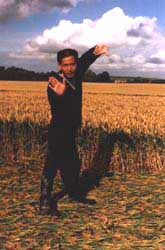
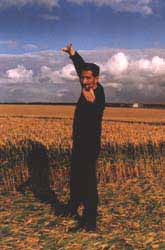
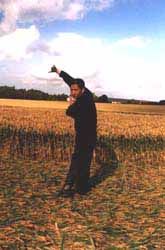

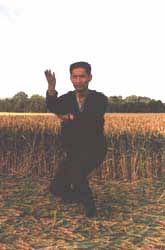
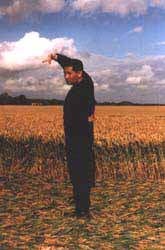 Crop Circle in the UK 1998
Crop Circle in the UK 1998 